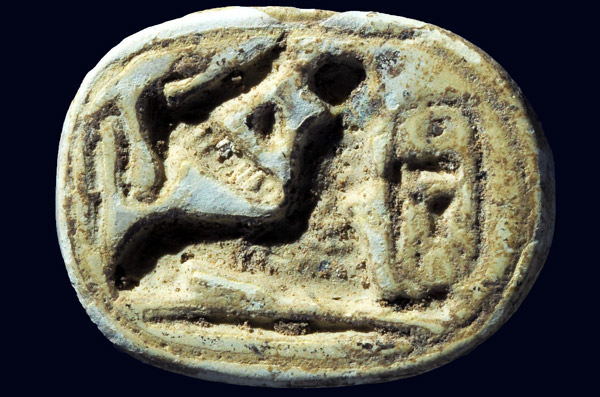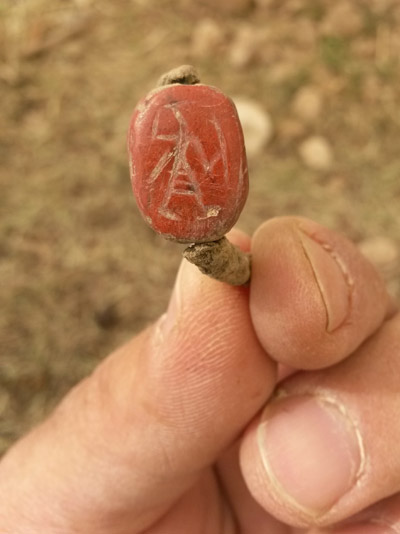(
Israel Antiquities Authority)
"The Israelites left Egypt; however, it seems that even years after their return Egypt did not leave the Israelites and their descendants," says archaeologist Amir Ganor of the Israel Antiquities Authority, who this past year directed an excavation in a cave in the vicinity of Kibbutz Lahav, in the south of the country.
At a press conference held in Jerusalem on the eve of Passover, the Israel Antiquities Authority revealed unique archaeological finds to the public, which attest to the existence of an Egyptian administrative center in the region 3,400 years ago.
While operating in the Tel Halif region, the Unit for the Prevention of Antiquities Robbery indentified an underground cave in which there were signs of plundering. The inspectors discovered that antiquities thieves had broken into the cave and began looting pottery vessels from 3,000 years ago and disturbed the ancient archaeological strata. The IAA officials thwarted further damage to the cave and carried out a salvage excavation there in order to save the artifacts and extremely valuable archaeological information from the robbers' pickaxes.
The excavation revealed impressive archaeological evidence dating mainly to the Late Bronze Age (circa 1500 BCE) and the Iron Age (1000 BCE). More than 300 pottery vessels of different types were found in the cave, some of which were discovered intact. Also found together with the pottery are dozens of pieces of jewelry made of bronze, shells and faience, unique vessels fashioned from yellowish alabaster, seals, seal impressions and cosmetic vessels. The objects had been placed in the cave and accumulated there for decades.
 A scarab seal of the Egyptian pharaoh Thutmose III with a sphinx crouching near the pharaoh’s nameCopyright: Clara Amit, courtesy Israel Antiquities Authority
A scarab seal of the Egyptian pharaoh Thutmose III with a sphinx crouching near the pharaoh’s nameCopyright: Clara Amit, courtesy Israel Antiquities AuthorityAccording to archaeologist Amir Ganor, director of the Unit for the Prevention of Antiquities Robbery at the Israel Antiquities Authority, "Among the many artifacts that were discovered, most of which are characteristic of the Judahite culture in the south of the country, we found dozens of stone seals, some of which are shaped in the form of a winged beetle (scarabs) and bear carved symbols and images typical of the Egyptian culture which prevailed in the country in the Late Bronze Age. Some of the seals were fashioned on semi-precious stones that come from Egypt and the Sinai Peninsula."
According to Dr. Daphna Ben-Tor, curator of Egyptian archaeology at the Israel Museum, "Most of the scarab seals found in the excavation date to the 15th-14th centuries BCE. During this period Canaan was ruled by Egypt." Dr. Ben-Tor adds, "The names of kings appeared on some of the seals. Among other things, we can identify a sphinx lying opposite the name of the pharaoh Thutmose who reigned from about 1504-1450 BCE. Another scarab seal bears the name of Amenhotep who reigned from about 1386-1349 BCE. Still another scarab depicts Ptah, the principal god of the city of Memphis."
Other artifacts discovered included seal rings made of faience and a wealth of figurines and amulets in the image of gods sacred to the Egyptian culture.
 Ring inlaid with a seal depicting an Egyptian warrior holding a shield and swordCopyright: Israel Antiquities Authority, Unit for the Prevention of Antiquities Robbery
Ring inlaid with a seal depicting an Egyptian warrior holding a shield and swordCopyright: Israel Antiquities Authority, Unit for the Prevention of Antiquities RobberyAccording to Ganor, "It is true the Israelites left Egypt but the evidence from the excavation in the cave shows the Egyptians did not leave the Israelites and their descendants. This has been attested to in archaeological excavations where we uncovered evidence from many years after the "Exodus" which reflects the influence of Egyptian culture on the Judahite residents of the country."
An examination of the finds shows that some of the objects were produced in Egypt itself and were brought to Canaan by the Israelites or merchants. However, some of the artifacts were made in the country using methods imitating Egyptian production techniques and copying Egyptian cultural motifs, while utilizing indigenous raw materials.
According to Dr. Amir Golani of the Israel Antiquities Authority, "During the Late Bronze Age Egypt was an extremely powerful empire and imposed its authority throughout our region. Egyptian authority was not only in manifested in political and military control, but was also a strong cultural influence that contributed to shaping society. Along with an administration of Egyptian officials in Israel, a group of local elite evolved in the country, who adopted many of the Egyptian customs and their artistry."
The artifacts were transferred to the laboratories of the Israel Antiquities Authority for further treatment. The investigation of the cave and the finds is still in its early stages and upon completing the treatment of the hundreds of objects that were exposed, it will be possible to add important information regarding Egypt's influence on the population of the Land of Israel in the biblical period.
Inspectors in the Unit for the Prevention of Antiquities Robbery expressed their satisfaction that in the wake of hard work and determination the antiquities robbery in the cave was thwarted, hundreds of finds were saved from plundering and looting, and archaeologists were able to carry out a systematic study of the site that will provide very valuable information for understanding the culture of the country in antiquity.